Abstract
We analyzed the appearance and level of Giardia muris-specific antibody of immunoglobulin A (IgA), IgG, and IgM isotypes, at weekly intervals, over the course of a 7-week infection in BALB/c and C57BL/6 mice. Using sensitive immunoradiometric assays, we observed that IgA antibody was the only detectable anti-G. muris antibody in intestinal secretions throughout the course of infection. No secreted IgG or IgM anti-G. muris antibody was detected even in concentrated intestinal secretions. The expulsion of G. muris by the mice was associated closely with the appearance and increasing levels of secreted anti-G. muris IgA antibody. Both IgG and IgA serum antibody to G. muris were detected, but no serum IgM antibody was detected. Serum IgA and IgG anti-G. muris antibody remained at high levels up to 10 weeks following clearance of the parasite. An interesting observation indicated that serum IgA antibody to G. muris developed more slowly in response to infection than secreted IgA antibody. An analysis of the molecular weight distribution of total serum IgA in infected mice determined that infection produced a transient but significant shift in serum IgA to high-molecular-weight (greater than or equal to dimeric IgA) forms. The results indicate that a substantial IgA antibody response occurs in sera and in gut secretions of G. muris-resistant mice and that IgA antibody is the dominant and possibly the only effector antibody active in intestinal secretions during G. muris infection in mice.
Full text
PDF
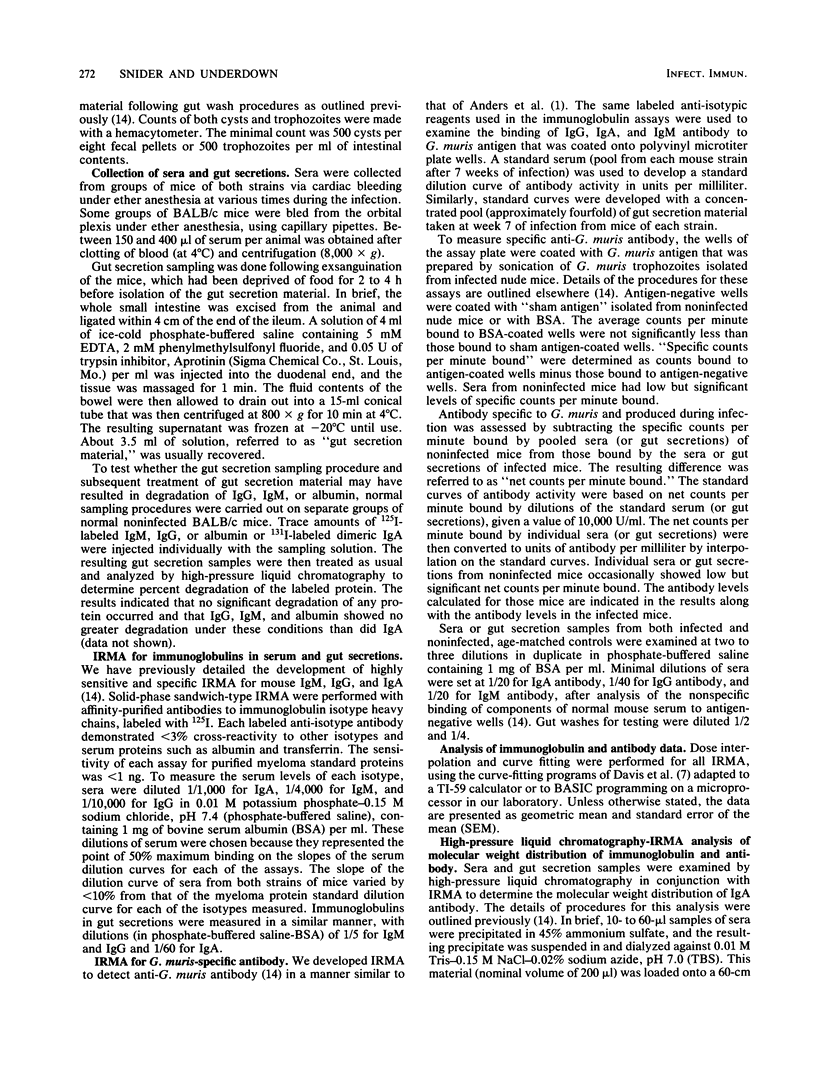
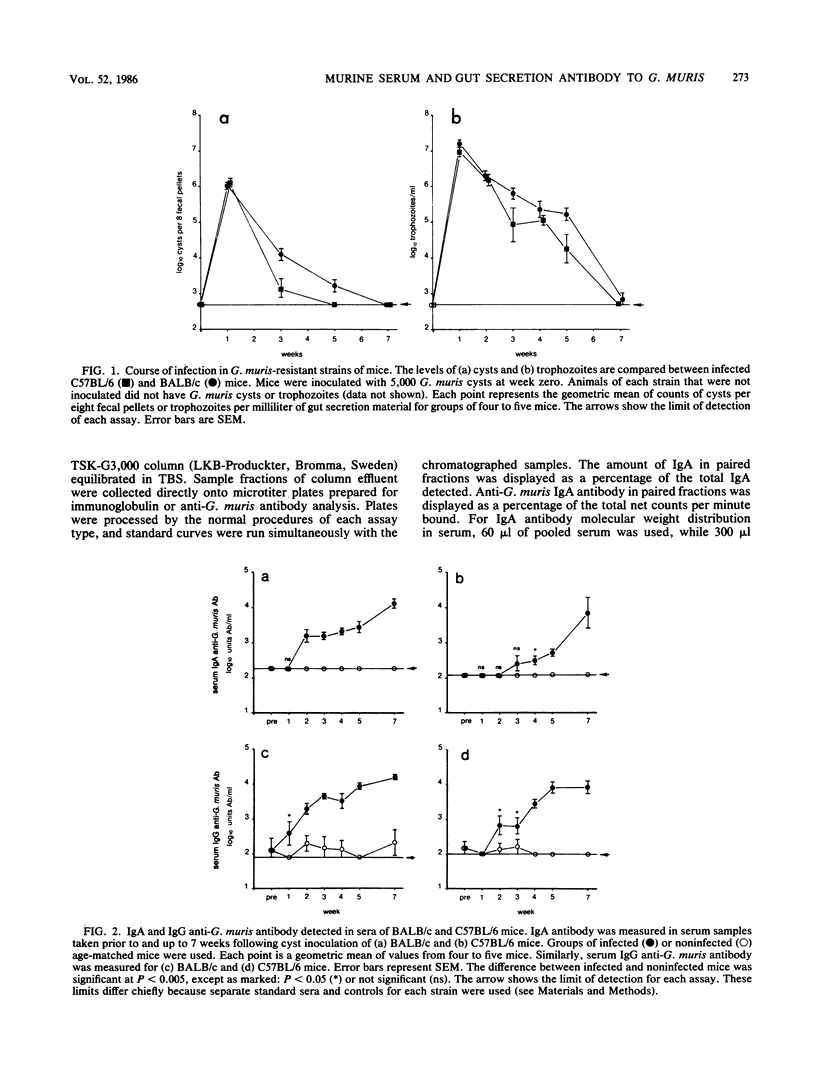
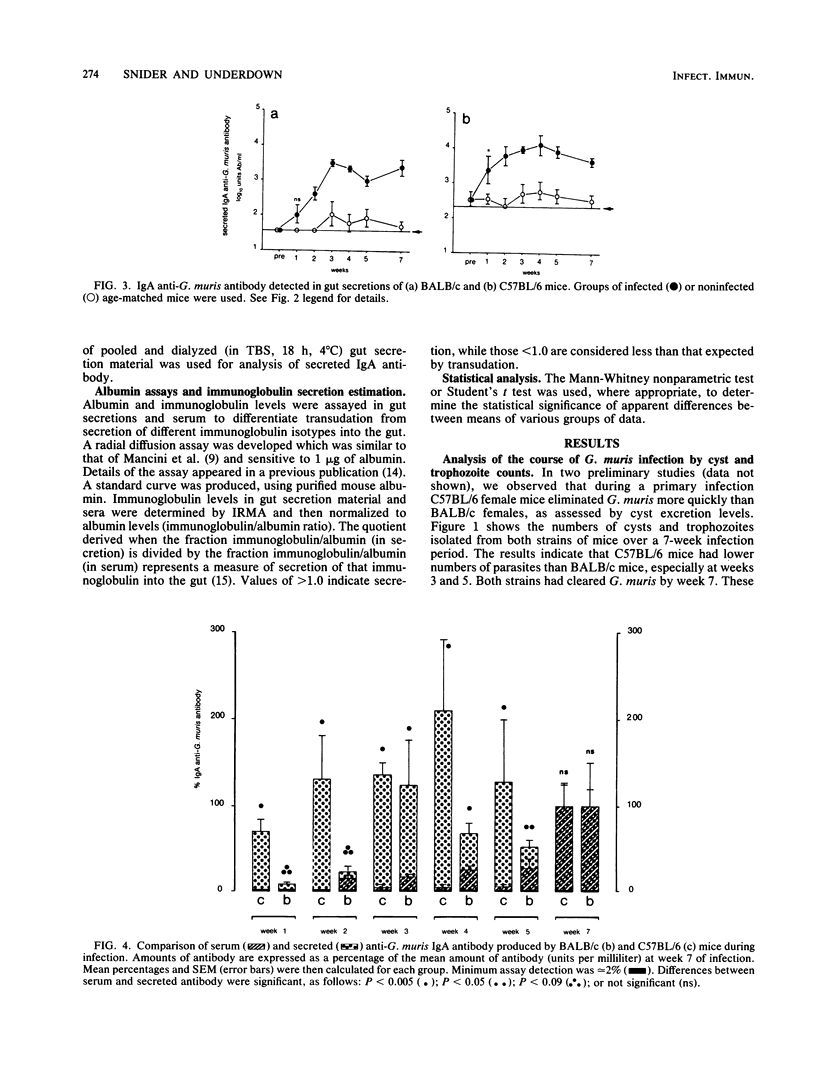
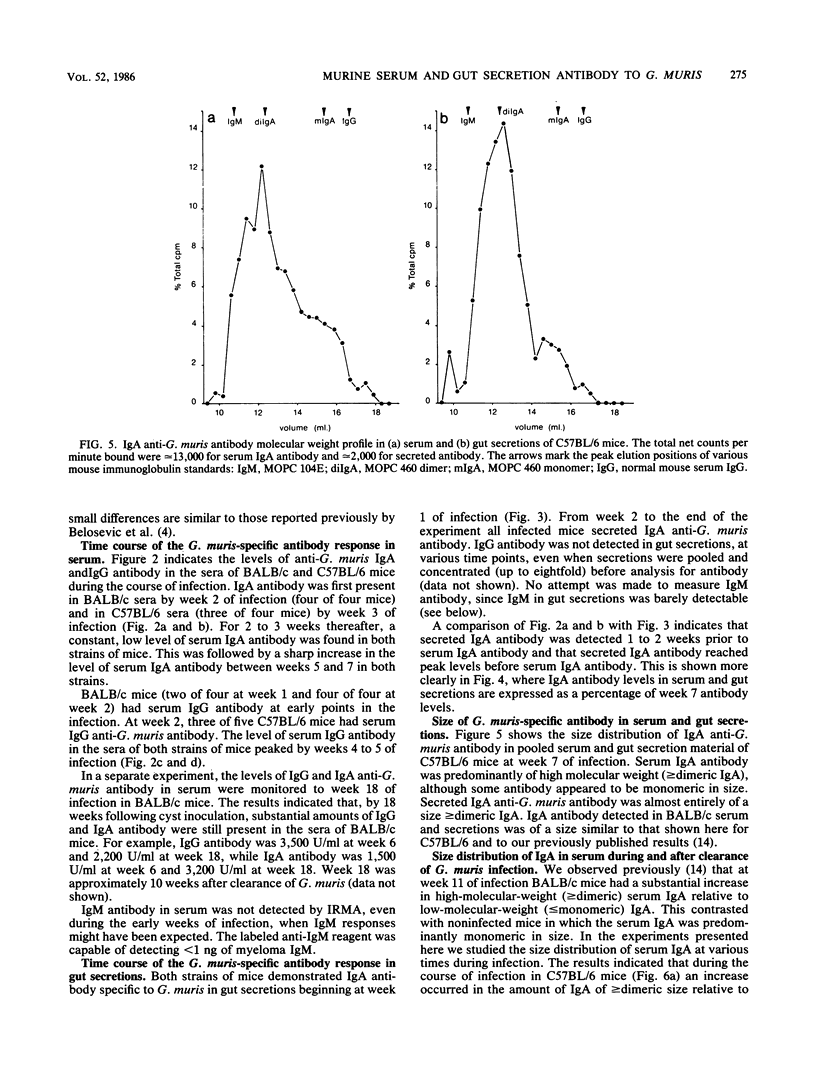

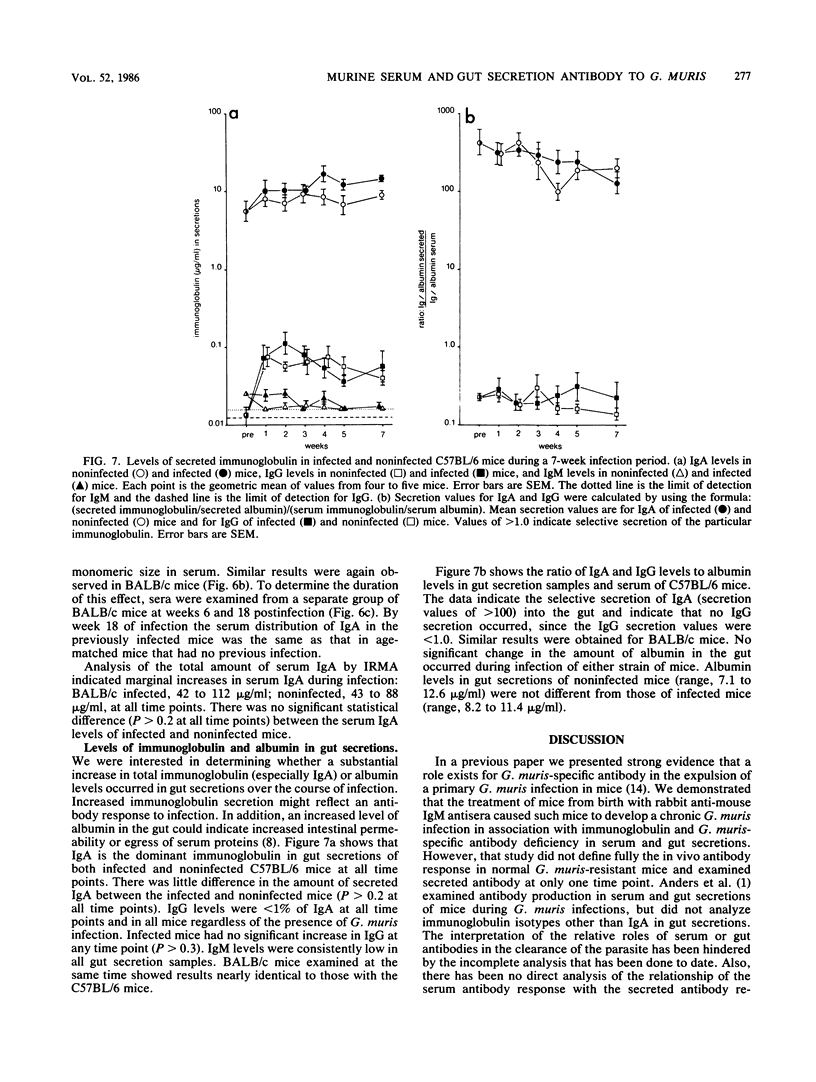
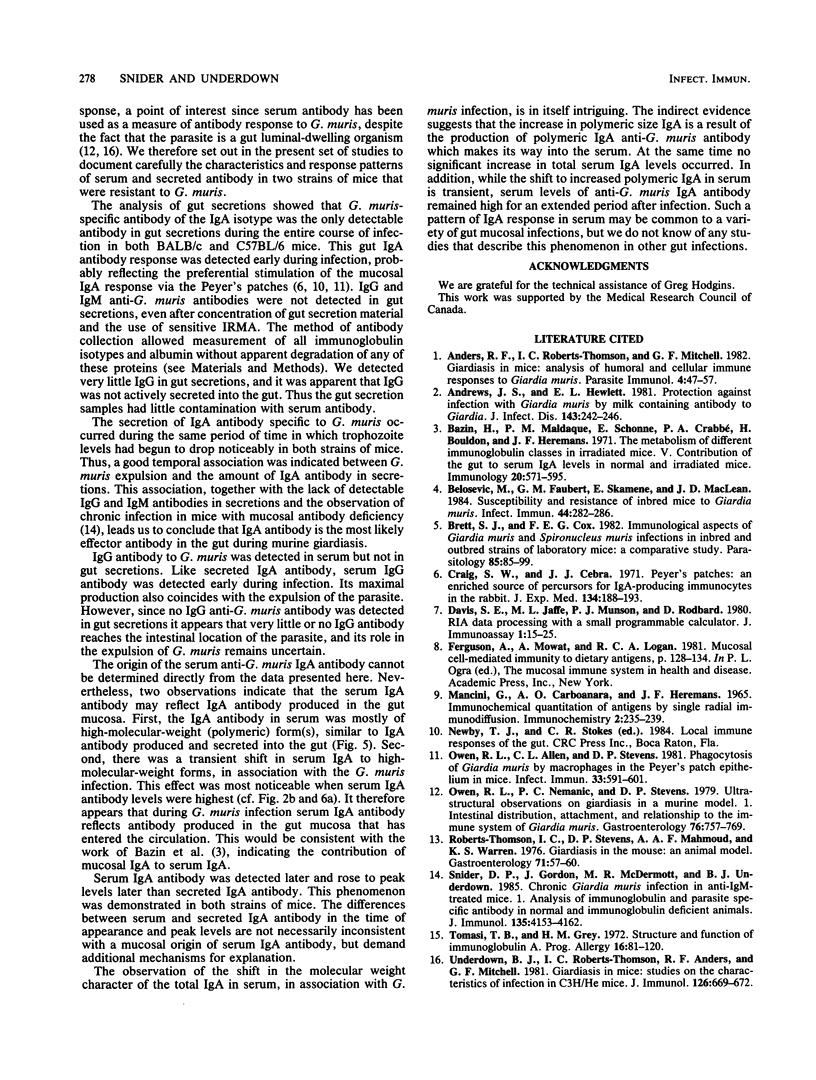
Selected References
These references are in PubMed. This may not be the complete list of references from this article.
- Anders R. F., Roberts-Thomson I. C., Mitchell G. F. Giardiasis in mice: analysis of humoral and cellular immune responses to Giardia muris. Parasite Immunol. 1982 Jan;4(1):47–57. doi: 10.1111/j.1365-3024.1982.tb00419.x. [DOI] [PubMed] [Google Scholar]
- Andrews J. S., Jr, Hewlett E. L. Protection against infection with Giardia muris by milk containing antibody to Giardia. J Infect Dis. 1981 Feb;143(2):242–246. doi: 10.1093/infdis/143.2.242. [DOI] [PubMed] [Google Scholar]
- Bazin H., Maldague P., Schonne E., Crabbé P. A., Bauldon H., Heremans J. F. The metabolism of different immunoglobulin classes in irradiated mice. V. Contribution of the gut to serum IgA levels in normal and irradiated mice. Immunology. 1971 Apr;20(4):571–595. [PMC free article] [PubMed] [Google Scholar]
- Belosevic M., Faubert G. M., Skamene E., MacLean J. D. Susceptibility and resistance of inbred mice to Giardia muris. Infect Immun. 1984 May;44(2):282–286. doi: 10.1128/iai.44.2.282-286.1984. [DOI] [PMC free article] [PubMed] [Google Scholar]
- Brett S. J., Cox F. E. Immunological aspects of Giardia muris and Spironucleus muris infections in inbred and outbred strains of laboratory mice: a comparative study. Parasitology. 1982 Aug;85(Pt 1):85–99. doi: 10.1017/s0031182000054172. [DOI] [PubMed] [Google Scholar]
- Craig S. W., Cebra J. J. Peyer's patches: an enriched source of precursors for IgA-producing immunocytes in the rabbit. J Exp Med. 1971 Jul 1;134(1):188–200. doi: 10.1084/jem.134.1.188. [DOI] [PMC free article] [PubMed] [Google Scholar]
- Davis S. E., Munson P. J., Jaffe M. L., Rodbard D. Radioimmunoassay data processing with a small programmable calculator. J Immunoassay. 1980;1(1):15–25. doi: 10.1080/01971528008055773. [DOI] [PubMed] [Google Scholar]
- Mancini G., Carbonara A. O., Heremans J. F. Immunochemical quantitation of antigens by single radial immunodiffusion. Immunochemistry. 1965 Sep;2(3):235–254. doi: 10.1016/0019-2791(65)90004-2. [DOI] [PubMed] [Google Scholar]
- Owen R. L., Allen C. L., Stevens D. P. Phagocytosis of Giardia muris by macrophages in Peyer's patch epithelium in mice. Infect Immun. 1981 Aug;33(2):591–601. doi: 10.1128/iai.33.2.591-601.1981. [DOI] [PMC free article] [PubMed] [Google Scholar]
- Owen R. L., Nemanic P. C., Stevens D. P. Ultrastructural observations on giardiasis in a murine model. I. Intestinal distribution, attachment, and relationship to the immune system of Giardia muris. Gastroenterology. 1979 Apr;76(4):757–769. [PubMed] [Google Scholar]
- Roberts-Thomson I. C., Stevens D. P., Mahmoud A. A., Warren K. S. Giardiasis in the mouse: an animal model. Gastroenterology. 1976 Jul;71(1):57–61. [PubMed] [Google Scholar]
- Snider D. P., Gordon J., McDermott M. R., Underdown B. J. Chronic Giardia muris infection in anti-IgM-treated mice. I. Analysis of immunoglobulin and parasite-specific antibody in normal and immunoglobulin-deficient animals. J Immunol. 1985 Jun;134(6):4153–4162. [PubMed] [Google Scholar]
- Tomasi T. B., Grey H. M. Structure and function of immunoglobulin A. Prog Allergy. 1972;16:81–213. [PubMed] [Google Scholar]
- Underdown B. J., Roberts-Thomson I. C., Anders R. F., Mitchell G. F. Giardiasis in mice: studies on the characteristics of chronic infection in C3h/He mice. J Immunol. 1981 Feb;126(2):669–672. [PubMed] [Google Scholar]


